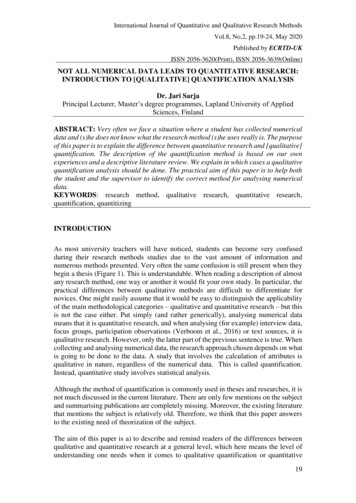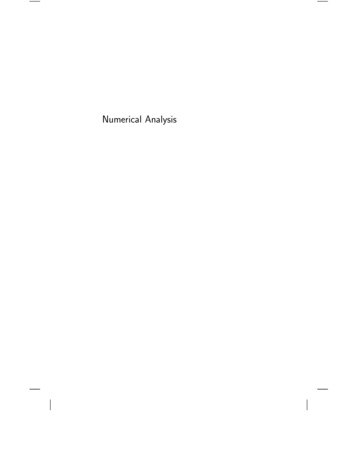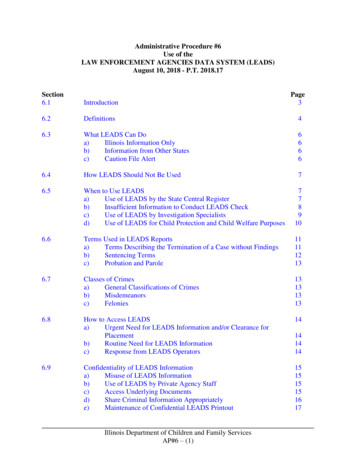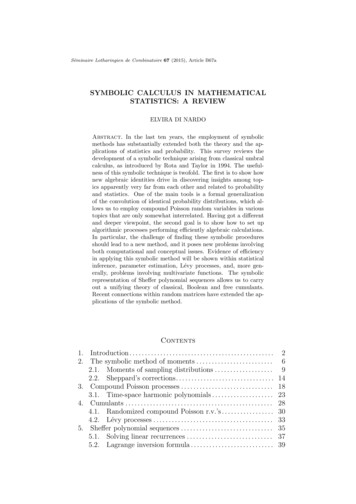
Transcription
International Journal of Quantitative and Qualitative Research MethodsVol.8, No.2, pp.19-24, May 2020Published by ECRTD-UKISSN 2056-3620(Print), ISSN 2056-3639(Online)NOT ALL NUMERICAL DATA LEADS TO QUANTITATIVE RESEARCH:INTRODUCTION TO [QUALITATIVE] QUANTIFICATION ANALYSISDr. Jari SarjaPrincipal Lecturer, Master’s degree programmes, Lapland University of AppliedSciences, FinlandABSTRACT: Very often we face a situation where a student has collected numericaldata and (s)he does not know what the research method (s)he uses really is. The purposeof this paper is to explain the difference between quantitative research and [qualitative]quantification. The description of the quantification method is based on our ownexperiences and a descriptive literature review. We explain in which cases a qualitativequantification analysis should be done. The practical aim of this paper is to help boththe student and the supervisor to identify the correct method for analysing numericaldata.KEYWORDS: research method, qualitative research, quantitative research,quantification, quantitizingINTRODUCTIONAs most university teachers will have noticed, students can become very confusedduring their research methods studies due to the vast amount of information andnumerous methods presented. Very often the same confusion is still present when theybegin a thesis (Figure 1). This is understandable. When reading a description of almostany research method, one way or another it would fit your own study. In particular, thepractical differences between qualitative methods are difficult to differentiate fornovices. One might easily assume that it would be easy to distinguish the applicabilityof the main methodological categories – qualitative and quantitative research – but thisis not the case either. Put simply (and rather generically), analysing numerical datameans that it is quantitative research, and when analysing (for example) interview data,focus groups, participation observations (Verboom et al., 2016) or text sources, it isqualitative research. However, only the latter part of the previous sentence is true. Whencollecting and analysing numerical data, the research approach chosen depends on whatis going to be done to the data. A study that involves the calculation of attributes isqualitative in nature, regardless of the numerical data. This is called quantification.Instead, quantitative study involves statistical analysis.Although the method of quantification is commonly used in theses and researches, it isnot much discussed in the current literature. There are only few mentions on the subjectand summarising publications are completely missing. Moreover, the existing literaturethat mentions the subject is relatively old. Therefore, we think that this paper answersto the existing need of theorization of the subject.The aim of this paper is a) to describe and remind readers of the differences betweenqualitative and quantitative research at a general level, which here means the level ofunderstanding one needs when it comes to qualitative quantification or quantitative19
International Journal of Quantitative and Qualitative Research MethodsVol.8, No.2, pp.19-24, May 2020Published by ECRTD-UKISSN 2056-3620(Print), ISSN 2056-3639(Online)research; b) to describe cases of qualitative quantification; and c) to explain based on aliterature review what quantification (or quantitizing) means. The practical purpose isto help students (especially at bachelor’s, but also at master’s level) and teachers tochoose the appropriate research method, particularly in cases where the collected dataare numerical.We discuss the topic by proceeding as follows. Firstly, we discuss the differencesbetween qualitative and quantitative research. Secondly, we describe whenquantification is to be used. Then we introduce the concept of quantification. Finally,we present the results of the paper.Figure 1. “My head is exploding. Somebody please help!”METHODOLOGYAlthough the quantification method is relatively widely used, there has not been muchdiscussion about it in the current literature. Therefore, it would be inappropriate to usea strictly regulated systematic literature review or meta-analysis. A descriptiveliterature review (Salminen, 2011) is more suitable. We found and reviewed twoFinnish research method books (Eskola & Suoranta, 2015; Tuomi & Sarajärvi, 2018)but only a handful of scientific papers. The latter were discovered by inputing thekeywords “quantification,” “quantitizing,” “quantizing,” “kvantifiointi” (the same inFinnish), “research method*,” “method*,” “qualitative*,” “data analysis,” “analysis ofdata,” and so on, and all possible combinations of these. If the keyword was presentedin a context other than research methods, the result was excluded.20
International Journal of Quantitative and Qualitative Research MethodsVol.8, No.2, pp.19-24, May 2020Published by ECRTD-UKISSN 2056-3620(Print), ISSN 2056-3639(Online)Quantitative and Qualitative Research MethodsAt the general level, the main differences between the use of quantitative and qualitativeresearch methodologies can be established by: a) the types of research questions thatare asked; b) the types of data that are best suited to provide the desired information; c)the amount of data that is needed to obtain the right information; d) the selection of theunits of analysis; and e) the nature of the processing of the collected data.Quantitative research methods are used to answer “what ?” questions (e.g. Marshall,1996) with cause and effect (e.g. Sullivan & Sargeant, 2011), and seeking generalizableresults (e.g. Marshall, 1996). In contrast, qualitative research methods are used toanswer “why ?” and “how ?” questions (e.g. Sullivan & Sargeant, 2011) with theminimum causality, and trying to describe separate phenomena (e.g. Cope, 2014).The data used in quantitative research are numerical (or countable). The countable datacan also be obtained from highly structured surveys (Sullivan & Sargeant, 2011) inwhich the respondent does not actually answer the numbered alternatives. Thequalitative data are usually text (Sullivan & Sargeant, 2011) that can be obtained fromvarious publications, writings, documents or transliterated interviews (and alwayssaved, in both audio and transcript format).The amount of data collected (from the sample) for quantitative and qualitative researchcan vary considerably. For quantitative research the sample size is typically large, andthe resultant data must be sufficient for statistical handling and reasoning. In the caseof qualitative research, it may vary from one, i.e. a single case study (e.g. Yin, 2009),to several, but the amount of data to be processed must achieve saturation, i.e. moredata would add no new information to the study (e.g. Marshall et al., 2013). At thispoint it is worthwhile consider the nature of the study; even in the case of single casestudy, a substantial amount of data can be collected, both textual and numerical. Theunits of analyses will be selected differently: randomly in the case of quantitativemethods, and intentionally in the case of qualitative methods (e.g. Eisenhardt, 1989;Runeson & Höst, 2009).The data collected in quantitative research are statistically processed (e.g. Libarkin &Kurdziel, 2002) with the help of statistical analysis computer software such as SPSS,SAS or Matlab. In a qualitative study, data are interpreted by identifying, coding, andcategorizing observations (e.g. Patton, 2002). As mentioned before, numerical data canbe analysed in qualitative studies, but not statistically. This is discussed further in thenext section.Qualitative Quantification AnalysisAll that exists, exists in some amount and can be measured.E. L. ThorndikeAs has been mentioned, the current method is widely used, but understudied. Probablymost of the authors of theses and researchers who have employed it do not even knowthey have. Quantification (or quantitizing) is a process of coding and analysingqualitative data quantitatively (Polit & Beck, 2004) and it is potentially a continuationof the process of data categorizing. The same principle applies the other way around,21
International Journal of Quantitative and Qualitative Research MethodsVol.8, No.2, pp.19-24, May 2020Published by ECRTD-UKISSN 2056-3620(Print), ISSN 2056-3639(Online)i.e. numerical data can be analysed qualitatively when it is not implemented statisticallyby using simple calculations such as addition, subtraction, multiplication or division.(Calculating averages depends on the context of the study. In principle, it is just a formof addition and division).Quantified qualitative analysis can be seen as a soft option when compared withquantitative methods (Eskola & Suoranta, 2015). The basic principle of quantificationis simple: to calculate attributes. This means that the number of times certain things (i.e.attributes) appear in the collected data will be calculated; or the number of participantswho express the same thing, and so on (Burns & Grove, 1997; Sandelowski, 2001;Tuomi & Sarajärvi, 2003; Polit & Beck, 2004). Examples of quantified data arepresented in Table 1. In many cases quantification produces significant additionalinformation compared with mere descriptions of the collected data (Tuomi & Sarajärvi,2003).In conclusion, we can say that we can answer “how many?” type research questionsusing quantitative analysis, and complete other kinds of research questions where wehave to examine the frequency of occurrence of some attribute or event (with no needfor statistical handling). So far in this paper we have explained when qualitativequantification analysis should be used. In the next section we provide a summary ofthis, and in addition we present a short test to ensure that quantification is the rightresearch or analysis method for your study.Further reading: an example of implementing quantification in a qualitative studyThe present author (Sarja, 2018) used the quantification method to deepen his ownunderstanding of his previous research. He divided the informants he had interviewedbefore into two groups, HW and SW. (The article explains what these groups mean, butthis is not important in the current context; here they simply represent two differentgroups of people.) The author calculated the “yes” and “no” attributes from the recodedresponses, and was thus able to compare their professional behaviour in terms ofsimilarities and differences. After benchmarking these, he was ready to makerecommendations to both groups.22
International Journal of Quantitative and Qualitative Research MethodsVol.8, No.2, pp.19-24, May 2020Published by ECRTD-UKISSN 2056-3620(Print), ISSN 2056-3639(Online)Table 1.Examples of quantified data.Data collection methodData sourceAttributeText analysesTextualsources(books,magazines, journals, reports, allforms of written material)InterviewsTranscription (i.e. of text)Simple¹ surveys, [answers to]open questions¹If the survey is not “simple”and its sample size is large, it ismost probably a quantitativestudy.Simple surveys, [answers to]structured questionnairesInformants’ written answersLetters, words, sentences (Sarja,2018), portions of pages orwords (Elo & Kyngäs, 2007),recurring themes or otherattributesRecurring themes or on,perspectives and phenomenaconsidered important to theresearcherRecurring themes or otherattributes, perspectives andphenomenaconsideredimportant to the e weighted responseoptions (eg. check the box, andso on)Own notes text material,audio- or AV recordings own notes or transcription (i.e.text), collected textual material,counted events, and so onThe countable numbers ofdifferent response options,without statistical processingRecurring themes or otherattributes, perspectives andphenomenaconsideredimportant to the researcherCONCLUSIONQuantification is a process of coding and analysing qualitative data quantitatively, orquantitative data qualitatively. It involves a process of analysis where we count events,or attributes. It may be seen as an easier alternative to quantitative methods. If it is thesole numeric method, it is part of a qualitative study.This simple test shows whether a study is qualitative, [qualitative] quantification orquantitative. Answer the following two questions:1)Is the collected data numerical? If the answer is “no,” the study is qualitative. Ifthe answer is “yes,” it may be either quantitative or quantification.2)If the collected data is numerical, is it processed using statistical analysissoftware or simple calculations? If the former, it is quantitative research. If the latter, itis quantification.ReferencesBurns, N. and Grove, S. (1997) The practice of nursing research. Conduct, critique &utilization, W.B. Saunders Co., Philadelphia.Cope, D. (2014) Methods and meanings: credibility and trustworthiness of qualitativeresearch, Oncology Nursing Forum, 41(1), 89 91.Eisenhardt, K. (1989) Building theories from case study research, Academy ofManagement Review, 4(1), 532 550.23
International Journal of Quantitative and Qualitative Research MethodsVol.8, No.2, pp.19-24, May 2020Published by ECRTD-UKISSN 2056-3620(Print), ISSN 2056-3639(Online)Elo, S. and Kyngäs, H. (2007) The qualitative content analysis process, Journal ofAdvanced Nursing, 62(1), 107 115.Eskola, J. and Suoranta, J. (2015) Johdatus laadulliseen tutkimukseen [An introductionto qualitative research], Vastapaino, Tampere. [in Finnish]Libarkin, J. and Kurdziel, J. (2002) Research methodologies in science education: thequalitative-quantitative debate, Journal of Geoscience Education, 50(1), 78 86.Marshall, M. (1996) Sampling for qualitative research, Family Practice, 13(6),522 525.Marshall, B., Cardon, P., Poddar, A. and Fontenott, R. (2013) Does sample size mattersin qualitative research? A review of qualitative interviews in IS research,Journal of Computer Information Systems, 54(1), 11 22.Patton, M. Q. (2002) Qualitative evaluation and research methods (3rd ed.), SagePublications, Newbury Park.Polit, D. and Beck, C. (2004) Nursing Research: principles and methods, JB LippincottCo, Philadelphia.Runeson, P. and Höst, M. (2009) Guidelines for conducting and reporting case studyresearch in software engineering, Empirical Software Engineering, 14(2),131 164.Salminen, A. (2011) Mikä kirjallisuuskatsaus? Johdatus kirjallisuuskatsauksentyyppeihin ja hallintotieteellisiin sovelluksiin [What literature review? Anintroduction to types of literature review and administrative scienceapplication], Vaasan yliopiston julkaisuja, Vaasa. [in Finnish]Sandelowski, M. (2001) Real qualitative researchers do not count: the use of numbersin qualitative research, Research in Nursing & Health, 24(3), 230 240.https://doi.org/10.1002/nur.1025Sarja, J. (2018) Success factors of radical breakthrough ICT projects – Comparison ofhardware and software cases, International Journal of Innovation, 6(1), 33 39.Sullivan, G. & Sargeant, J. (2011) Qualities of qualitative research: Part I, Journal ofGraduate Medical Education, 3(4), 449 452.Tuomi, J. and Sarajärvi, A. (2018) Laadullinen tutkimus ja sisällönanalyysi [Qualitativeresearch and content analysis], Tammi, Helsinki. [in Finnish]Verboom, B., Montgomery, P. & Bennet, S. (2016) What factors affect evidenceinformed policymaking in public health? Protocol for a systematic review ofqualitative evidence using thematic synthesis, Systematic Reviews, 5(1), no. 61.https://doi.org/10.1186/s13643-016-0240-6.Yin, R. K. (2009) Case study research: design and methods, Sage Publications, LosAngeles.24
International Journal of Quantitative and Qualitative Research Methods Vol.8, No.2, pp.19-24, May 2020 Published by ECRTD-UK ISSN 2056-3620(Print), ISSN 2056-3639(Online) 21 Quantitative and Qualitative Research Methods At the general level, the main differences between the use of quantitative and qualitative











